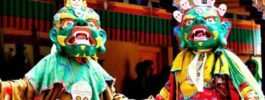The Kumbh Mela is one of the most ancient and revered religious festivals in India, drawing millions of pilgrims from all over the world to partake in its spiritual rituals and festivities. The origins of the Kumbh Mela can be traced back to Hindu mythology, specifically the story of the churning of the ocean of milk, known as the Samudra Manthan.
According to Hindu scriptures, during the churning of the ocean by the gods (Devas) and demons (Asuras) to obtain the nectar of immortality (Amrit), a few drops of the elixir fell at four different locations on Earth – Prayag (modern-day Allahabad), Haridwar, Ujjain, and Nashik. These drops of nectar are believed to have sanctified the rivers at these locations, making them auspicious for bathing during specific astrological alignments.
Evolution of the Kumbh Mela
Over the centuries, the Kumbh Mela evolved from a local religious gathering into a grand festival of epic proportions. The first historical accounts of the Kumbh Mela date back to the 8th century, during the time of Adi Shankaracharya, a renowned Hindu philosopher and theologian. Shankaracharya is credited with organizing the Kumbh Mela as a means of uniting the diverse sects within Hinduism and promoting spiritual harmony.
As the centuries passed, the Kumbh Mela grew in scale and significance, attracting pilgrims, saints, and scholars from across India and beyond. The festival became a platform for spiritual discourse, cultural exchange, and religious fervor, with millions of people converging at the designated holy sites to bathe in the sacred rivers and seek blessings from the Sadhus (holy men) in attendance.
Significance of the Kumbh Mela
The Kumbh Mela holds immense spiritual and cultural significance for Hindus, who believe that bathing in the holy rivers during the festival washes away sins and grants salvation. It is also a time for devotees to seek blessings, perform rituals, and partake in religious ceremonies conducted by revered spiritual leaders.
The Kumbh Mela is not just a religious gathering but a celebration of India’s rich cultural heritage, where traditional music, dance, and art forms take center stage. The festival is a melting pot of diverse traditions and practices, showcasing the unity in diversity that is inherent in Indian culture.
From Ancient Roots to Modern-Day Mahakumbh
In recent times, the Kumbh Mela has grown into a massive event, with the Maha Kumbh Mela held every 12 years at Prayag being the most grand and auspicious of them all. The Maha Kumbh Mela attracts millions of pilgrims and tourists, making it one of the largest religious gatherings in the world.
The modern-day Kumbh Mela is a logistical marvel, with temporary tent cities sprawling over vast tracts of land to accommodate the influx of visitors. The government, along with various organizations, work tirelessly to ensure the smooth functioning of the festival, providing amenities, security, and medical facilities to the millions in attendance.
In conclusion, the Kumbh Mela stands as a testament to the enduring spiritual legacy of India, where ancient traditions and beliefs continue to thrive in a rapidly changing world. The festival’s ability to adapt and evolve while staying true to its roots is a testament to the timeless appeal of this sacred gathering that transcends boundaries of religion, caste, and creed.







